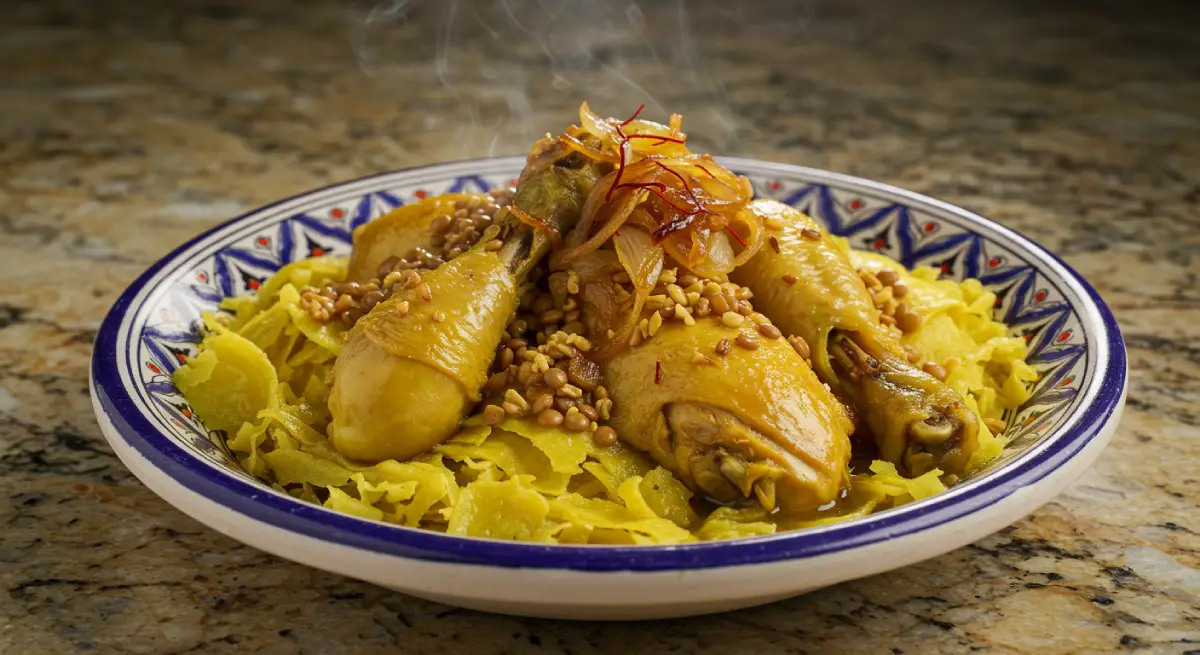🥘 What Makes Rfissa a Typical Moroccan Meal?
Table of Contents
Rfissa: A Dish That Brings Moroccan Families Together
If you’ve ever stepped into a Moroccan home during a celebration — a birth, a family gathering, or just a chilly Sunday — chances are, you’ve tasted Rfissa.
Made with slow-cooked chicken, lentils, and that unmistakable touch of fenugreek, Rfissa isn’t just food — it’s comfort on a plate. Its rich broth soaks warm layers of msemen or trid, and the aroma alone is enough to pull everyone to the table.
This iconic Moroccan dish has even been featured on Taste of Maroc, where its rich history and comforting flavors are beautifully showcased.
In this guide, I’ll walk you through how to make an authentic Moroccan Rfissa just like we do at home — full of flavor, warmth, and tradition.
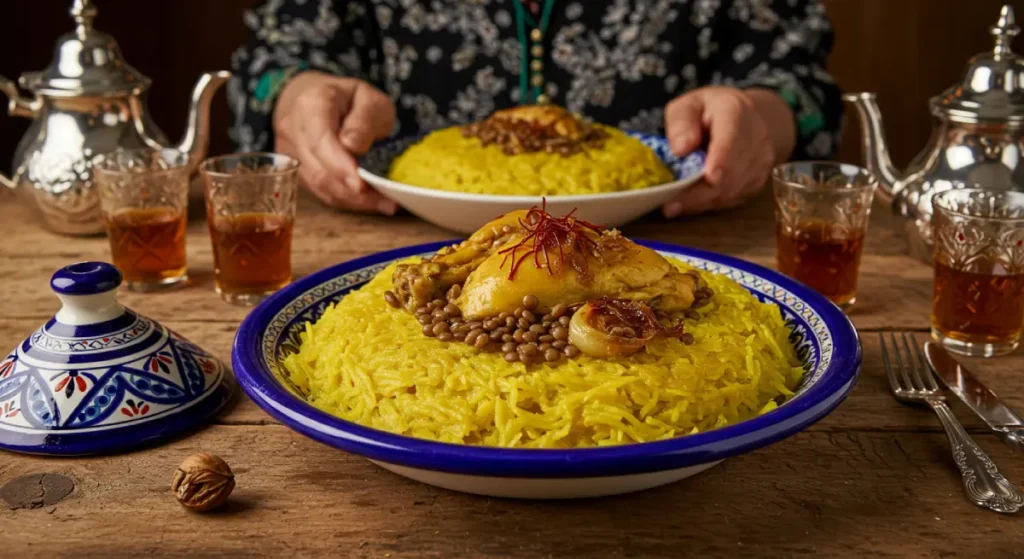
Origins of Rfissa – A Historical Dish in Moroccan Cuisine
Rfissa isn’t just a delicious Moroccan comfort food — it’s a dish with centuries of history layered into every bite.
📜 Berber Roots
Long before Moroccan cuisine became globally recognized, Berber communities were slow-cooking hearty stews made with grains, legumes, and warming spices. Rfissa reflects this legacy perfectly — a dish built on tradition and nourishment.
🍞 The Trid Connection
At the heart of Rfissa is Trid, a delicate, thin, hand-torn bread. Once served to scholars, nobles, and during special ceremonies, Trid adds both texture and symbolism — a sign of generosity and celebration.
🕰️ A Dish that Evolved with Time
While Rfissa has ancient roots, it has gracefully evolved. The blend of chicken, lentils, fenugreek, and saffron remains classic, but families across Morocco add their own touches — making every Rfissa a little different, yet deeply familiar.
➡️ This depth of history is why Rfissa continues to hold its place as a beloved traditional dish — both nourishing and meaningful.
Why It’s Special – Symbol of Hospitality and Tradition
In Morocco, food is never just food — it’s how we welcome, share, and show love. Rfissa captures this spirit perfectly.
🍽️ A Dish Meant to Be Shared
Rfissa is always served in the center of the table, where everyone gathers around. It’s not just about eating — it’s about coming together, laughing, talking, and feeling at home. That’s what makes it a true Moroccan experience.
🥣 Comforting, Nourishing, and Meaningful
With its rich blend of lentils, fenugreek, and tender chicken, Rfissa nourishes both body and soul. It’s the kind of dish that gives you strength when you need it most — not just physically, but emotionally too.
🌿 A Healing Tradition for New Mothers
In many Moroccan homes, Rfissa is the dish you make for a woman who just gave birth. The fenugreek (halba) is believed to support recovery, boost energy, and promote healing — a tradition passed down through generations with care.
➡️ Rfissa isn’t just a typical Moroccan meal — it’s a gesture of love, comfort, and heritage, all served on one plate.
When Is Rfissa Served? – Celebrations, Postpartum Recovery, and Ramadan
Rfissa is a typical Moroccan meal that goes beyond everyday food — it’s reserved for life’s most meaningful moments.
🤱 For New Mothers – A Gift of Strength
In Moroccan homes, this nourishing dish is traditionally prepared for women after childbirth. As a typical Moroccan meal rooted in care and tradition, it combines lentils, chicken, and fenugreek (halba) to help restore energy and promote healing. It’s often offered by grandmothers and loved ones as a warm gesture of support.
🎉 For Family Gatherings and Celebrations
Rfissa also plays a role during festive occasions like Eid and large family gatherings. Like many typical Moroccan meals, it’s served in a shared dish placed at the center of the table — turning each meal into a moment of togetherness.
🌙 During Ramadan – When Nourishment Matters Most
Though not served every night, Rfissa occasionally appears during Iftar, especially in homes that treasure traditional, slow-cooked comfort foods. It’s the kind of typical Moroccan meal that brings energy, meaning, and comfort after a long day of fasting.
➡️ Whether it’s for healing, celebration, or faith, Rfissa represents everything a typical Moroccan meal should be — generous, comforting, and deeply rooted in tradition.
✨ Why Rfissa Truly Defines a Typical Moroccan Meal
If one dish could capture the spirit of Moroccan cooking, it would be Rfissa. With its centuries-old roots, healing ingredients, and role in life’s most intimate moments, it’s more than food — it’s memory, care, and connection on a plate.
Whether served after childbirth, during religious celebrations, or at large family feasts, Rfissa stands as the ultimate example of what a typical Moroccan meal should be: generous, heartfelt, and steeped in tradition— much like other festive Moroccan classics such as the Chicken Tagine with Prunes and Cinnamon.
🌿 Essential Ingredients for an Authentic Rfissa
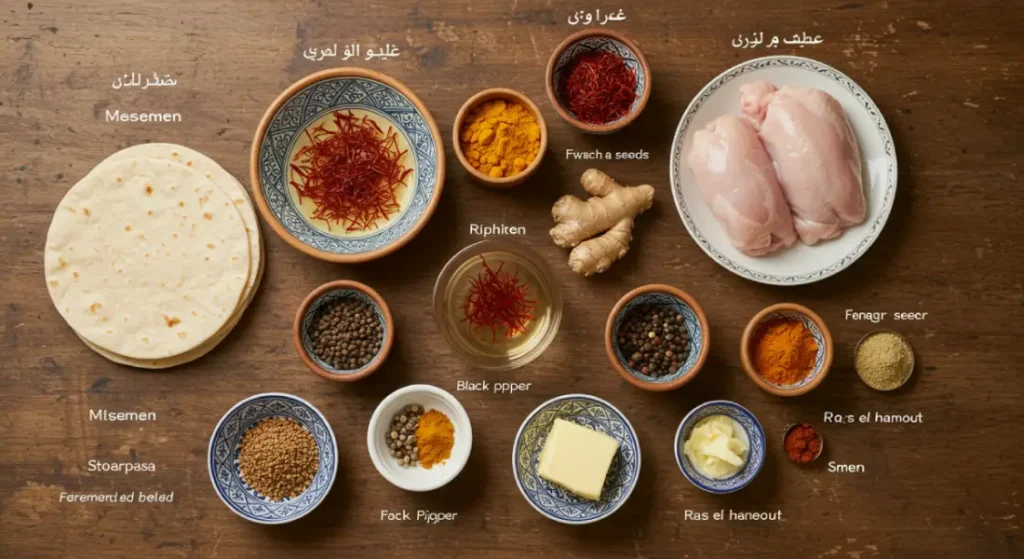
Rfissa wouldn’t be a typical Moroccan meal without its essential ingredients. This dish shines through its rich layers of flavor, combining tender chicken, slow-cooked lentils, aromatic spices, and msemen — a traditional Moroccan flatbread forming the heart of the dish.
Let’s break down what gives Rfissa its authentic taste and cultural depth.
🥖 Msemen / Trid – The Foundation of Rfissa
Bread plays a central role in any authentic typical Moroccan meal, and in Rfissa, it’s all about Trid — thin, delicate Moroccan flatbread traditionally torn into pieces and layered beneath the stew.
- What is Trid? Also known as “Moroccan crepes”, Trid is a fine, flaky flatbread made by repeatedly folding and stretching dough. Its texture is light yet sturdy enough to absorb the flavorful broth.
- Why is it essential? Unlike couscous or rice, Trid soaks up the rich juices of the dish, giving Rfissa its signature soft yet complex base.
- Can Msemen replace Trid? Absolutely. Msemen, a thicker, square version of Moroccan flatbread, works perfectly if Trid is unavailable.
🧠 Learn more about Moroccan breads like msemen and Trid
Using trid or msemen is one defining element that sets Rfissa apart from other typical Moroccan meals.
🍗 Chicken & Lentils – A Slow-Cooked Delight
Rfissa is built around the combination of protein-rich chicken and nutrient-packed lentils, slow-cooked to perfection for deep flavor and nourishment.
✔ Chicken – The Star of Rfissa
- Traditionally, free-range chicken is preferred for its flavor and firm texture.
- It simmers in a spiced broth that infuses every bite with Moroccan essence.
✔ Lentils – A Moroccan Superfood
- Lentils are key in many Moroccan dishes. In Rfissa, they provide an earthy, hearty base that complements the richness of the spices.
- They’re also high in iron, fiber, and protein, making Rfissa a filling and restorative dish.
🌿 Discover the health benefits of lentils
📌 Also visit out our Moroccan Lentil Stew recipe — another simple and flavorful dish made with lentils!
🌶️ Signature Spices – The Soul of Moroccan Cuisine
A typical Moroccan meal wouldn’t be complete without its spices. In Rfissa, they bring out warmth, complexity, and balance:
Key Spices That Give Rfissa Its Authentic Flavor:
- Ras el Hanout – A spice blend with up to 30 ingredients, such as cumin, cardamom, and nutmeg.
🌐 More about Ras el Hanout - Saffron – Known as the gold of spices, it lends Rfissa a floral aroma and golden color.
🌐 Saffron’s nutritional and health properties - Fenugreek (Halba) – A key ingredient for its nutty bitterness and postpartum healing properties.
🌐 Fenugreek: Uses and benefits - Smen (Aged Butter) – A fermented butter that adds depth and authenticity to Moroccan dishes.
- Chili Pepper (optional) – Some versions include chili for a light kick.
💪 Health Benefits – The Power of Moroccan Ingredients
Rfissa isn’t just delicious—it’s also incredibly nutritious. Here’s why it’s considered a healing meal in Moroccan tradition:
- Rich in Protein & Iron – Chicken and lentils fuel muscle repair and energy.
- Digestive Support – Fenugreek and cumin are known for aiding digestion and reducing bloating.
- Anti-Inflammatory Properties – Thanks to spices like saffron and turmeric.
- Postpartum Support – Fenugreek is used traditionally to help new mothers recover.
- Long-Lasting Energy – A combination of slow carbs and proteins keeps you fuller, longer.
🍽️ Why These Ingredients Make Rfissa a Typical Moroccan Meal
Rfissa is a perfect representation of Moroccan cooking because it blends:
✅ Handmade flatbread (Trid or Msemen)
✅ Slow-cooked chicken and lentils
✅ Traditional Moroccan spices
✅ Ingredients known for their health and cultural value
Each bite reflects the depth of Moroccan heritage, making it more than just food — it’s memory, care, and tradition.
🍳 Step-by-Step Guide to Cooking Rfissa at Home
Rfissa is a typical Moroccan meal that rewards patience, precision, and love for tradition. While the process might seem detailed, this step-by-step guide will help you recreate the dish like a true Moroccan home cook.
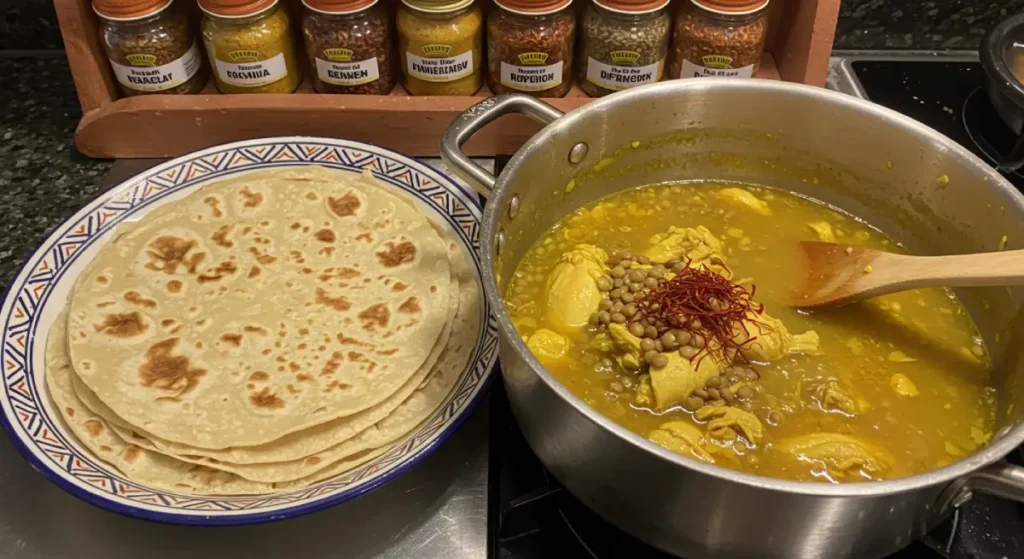
In this section, we’ll break down the process into four key steps: preparing the chicken broth, cooking the lentils, assembling the dish, and adding the final touches for a stunning presentation.
🥘 Step 1 – Preparing the Saffron Chicken Broth
The soul of any typical Moroccan meal like Rfissa lies in the broth. Slow-cooked chicken infused with saffron, Moroccan spices, and aged butter (smen) creates a deep, rich base full of flavor.
Ingredients:
- 1 whole chicken (preferably free-range)
- 1 large onion, 2 garlic cloves (grated)
- Salt, pepper, turmeric, ginger, paprika, coriander seeds
- A few saffron threads soaked in warm water
- 1 tsp of smen (Moroccan fermented butter)
- 3 tbsp olive oil
- 1 bunch of fresh coriander and parsley (tied)
- 1 liter boiling water
- 1 tsp of ras el hanout (or Rfissa spice mix)
Instructions:
- Heat olive oil in a large pot. Add onions and garlic until softened.
- Place the chicken in the pot and season it with all the spices.
- Add saffron water, ras el hanout, and smen. Stir well.
- Pour in the boiling water, add the herb bundle, cover, and let it simmer for 1 hour.
🔗 Learn more about smen – Moroccan fermented butter (The Spruce Eats)
🥄 Step 2 – Cooking the Lentils and Seeds
Lentils are a nutritional cornerstone in this typical Moroccan meal. Cooked just right, they add texture and earthy flavor without becoming mushy.
Ingredients:
- 80g dried lentils
- 50g dried fava beans (optional)
- 50g fenugreek seeds
- 1 tsp nigella seeds
- 1 tsp cress seeds
Instructions:
- Rinse all the seeds thoroughly.
- Add them to the simmering chicken broth.
- Cook for 30–40 minutes until tender but intact.
- Add more hot water as needed to maintain enough broth.
🍽️ Step 3 – Assembling the Dish with Msemen
Unlike couscous or rice, Rfissa is layered with shredded msemen or trid — flatbreads that soak up the flavorful broth beautifully.
Instructions:
- Cut msemen (or trid) into bite-sized pieces. Let fresh msemen dry slightly before cutting.
- Spread the msemen on a large serving platter.
- Gradually ladle the hot broth over it so it soaks up flavor without getting soggy.
- Add the lentils and beans on top.
- Place the chicken in the center.
- Pour more broth around the dish for full coverage.
📌 Looking for a different twist? Try our Moroccan Chicken Tagine — a slow-cooked classic full of bold spices and tender chicken.
🌿 Step 4 – Final Touches & Presentation
A typical Moroccan meal is not only about flavor — it’s about presentation and warmth.
Suggestions:
- Crisp the Chicken: Brush it with butter and broil briefly for a golden finish.
- Saffron Drizzle: Add a touch of saffron water for aroma and color.
- Fresh Herbs: Sprinkle chopped coriander and parsley.
- Elegant Garnishes: Some Moroccan chefs add quail eggs or chia seeds for flair.
Serving Tips:
- Serve immediately while warm.
- Present it in the center of the table for communal eating.
- Pair with Moroccan mint tea for a balanced, traditional experience.
🍛 Why This Step Defines a Typical Moroccan Meal
Rfissa represents the essence of a typical Moroccan meal — slow-cooked, spice-rich, and built around sharing. From the careful layering of msemen to the fragrant broth and heartfelt presentation, every element reflects Moroccan culinary values.
By following these steps, you’re not just cooking — you’re embracing a legacy.
🍽️ Serving & Enjoying Rfissa Like a Local
Rfissa is far more than a delicious stew — it’s a typical Moroccan meal rooted in the values of hospitality and community. Every detail in how it’s served reflects the spirit of Moroccan culture.
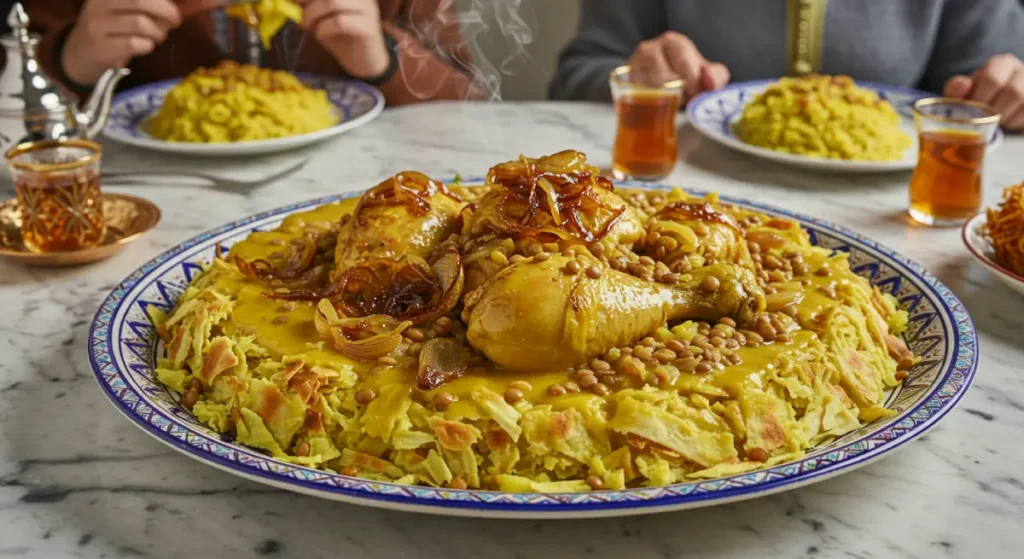
🍛 How to Serve Rfissa – Family-Style Presentation
One thing that defines a typical Moroccan meal is the art of presentation. In Moroccan households:
- Rfissa is traditionally presented in a shallow, generously sized serving dish, allowing the flavorful broth to soak evenly into the layers of msemen.
- At the heart of the dish lies the tender chicken, golden from slow cooking, nestled among gently simmered lentils and fragrant fenugreek.
- The dish is often garnished with fresh herbs, saffron water, and occasionally quail eggs for a festive touch.
- Moroccans eat Rfissa with pieces of msemen instead of cutlery, symbolizing unity and tradition.
👉 This way of serving transforms a simple meal into a collective experience, strengthening bonds between family and guests.
🍵 Best Pairings – Traditional Moroccan Drinks
A typical Moroccan meal like Rfissa calls for equally traditional drinks to complement its flavors:
- Moroccan mint tea, both soothing and slightly sweet, offers the perfect contrast to the savory depth of Rfissa.
- Buttermilk (Lben): A tangy drink that aids digestion after a hearty meal.
- Fresh Orange Juice: Often served during lunch, it adds a bright citrus contrast.
- Herbal Infused Water: Some prefer rose or thyme-infused water for a fragrant, light finish.
These drinks aren’t just refreshing — they’re part of a broader ritual that makes Moroccan meals so memorable.
🤝 Rfissa and Moroccan Hospitality – A Dish for Sharing
In Moroccan culture, sharing a meal is more than tradition — it’s a heartfelt expression of care, respect, and hospitality. That’s why Rfissa is often the first choice for:
- Welcoming guests or honoring family visits
- Celebrating a new birth (due to fenugreek’s healing properties)
- Special occasions like Eid or weddings
Rfissa symbolizes the heart of Moroccan hospitality: generosity, care, and togetherness.
🌍 Variations of Rfissa – Regional Twists
While the core recipe remains similar, Rfissa can vary across Morocco:
- Traditional Chicken Rfissa: Common in Rabat and Casablanca
- Rfissa with Pigeon (Rfissa B’hamam): Found in Fez and Meknes
- Vegetarian Rfissa: Popular in urban households with chickpeas and mushrooms
- A bold variation from southern Morocco swaps chicken for lamb, delivering a deeper, spicier flavor typical of the Souss culinary style.
These versions prove how one typical Moroccan meal can reflect the culinary identity of different regions.
✨ The True Experience of Eating Rfissa Like a Local
Rfissa is about sharing more than food. It’s about sharing stories, care, and heritage:
✔ Served in one dish for everyone to enjoy together
✔ Accompanied by mint tea or Lben for a full sensory experience
✔ Reserved for life’s special moments and treasured guests
✔ Personalized with local touches from region to region
🟢 Discover another lentil-based Moroccan comfort food in our Moroccan Lentil Stew recipe — a perfect dish for quick and nourishing meals.
For more insight into traditional Moroccan cuisine, explore BBC Good Food’s guide to Moroccan recipes — an excellent source for discovering authentic flavors.
In every region and every home, Rfissa remains a typical Moroccan meal that brings people together in the most heartfelt way possible.
💡 Tips for a Perfect Rfissa Every Time
Rfissa is a typical Moroccan meal that relies on patience, ingredients, and proper technique to achieve its signature taste and texture. No matter your level in the kitchen, following these tips will guide you toward preparing a rich, well-seasoned Rfissa that stays true to its Moroccan roots.
In this section, we’ll cover the most critical aspects of making the best Rfissa, including choosing the proper chicken, adjusting spices, preventing common mistakes, and exploring lighter versions of the dish.
🐓 Choosing the Right Chicken – Why Free-Range Chicken Is Best
One of the key elements of a typical Moroccan meal like Rfissa is the quality of the chicken. The type of chicken you use will significantly affect the dish’s taste, texture, and overall richness.
Best Type of Chicken for Rfissa:
✔ Free-range chicken (Djej Beldi)
- Traditional Moroccan households often use free-range chicken, Djej Beldi, for its firmer texture and richer flavor.
- This type of chicken requires longer cooking time, but it produces a deep, savory broth that enhances the dish.
✔ Farm-raised or supermarket chicken
- If free-range chicken is unavailable, you can use farm-raised chicken, but keep in mind that it cooks faster and may not develop as much depth of flavor.
- Add extra spices, saffron, and smen (fermented butter) to the broth to compensate for the milder taste.
🔹 Pro Tip: For a deeper flavor, marinate the chicken in spices and smen a few hours before cooking.
🌶️ Mastering the Spices – Adjusting Flavors for the Perfect Balance
One of the defining characteristics of a typical Moroccan meal is the expert use of spices. To create a well-balanced Rfissa, it’s essential to understand how each spice contributes to the dish.
Key Spice Adjustments for the Best Rfissa:
✔ Saffron – Adds aromatic depth and color. Soak just a pinch of saffron threads in warm water to fully release their aroma and color.
✔ Turmeric & Paprika – Provide warmth and earthiness. Adjust based on taste preference.
✔ Ginger and black pepper lend a subtle heat that enhances the dish’s depth without overpowering it.. Use less pepper for a milder version.
✔ Fenugreek (Halba) – Soak seeds beforehand to reduce bitterness.
✔ Smen (Fermented Butter) – Adds umami. If unavailable, use ghee in moderation.
🔹 Pro Tip: Prefer spicier? Add a pinch of chili powder or serve with harissa.
🚫 Avoiding Common Mistakes – Preventing Soggy Msemen
A typical Moroccan meal should balance textures, and soggy msemen is a common pitfall in Rfissa.
How to Prevent Soggy Msemen:
✔ Use slightly dry msemen
- Fresh msemen can become mushy. Let it rest or lightly toast before use.
✔ Layer the broth gradually
- Add broth in small ladles to avoid oversaturation.
✔ Serve immediately
- Serve fresh to prevent msemen from over-absorbing liquid.
✔ Use a slotted spoon for lentils
- To control broth volume, use a slotted spoon when adding lentils and fenugreek.
🔹 Pro Tip: If too much broth is added, briefly heat in the oven to evaporate excess liquid.
🥗 Making It Healthier – Lighter Versions of Rfissa
While Rfissa is traditionally rich and hearty, you can make a lighter version without sacrificing flavor.
Healthier Ingredient Swaps:
✔ Use skinless chicken
- Removing skin lowers fat while maintaining flavor.
✔ Reduce smen
- Use a bit of olive oil instead of large amounts of smen.
✔ Increase lentils, decrease msemen
- More lentils = more fiber and protein, fewer refined carbs.
✔ Bake msemen instead of pan-frying
- A baked version uses less oil.
✔ Add vegetables
- Try carrots, zucchini, or spinach for added nutrients.
🔹 Pro Tip: Try whole wheat flatbread or brown rice as substitutes for msemen for a lighter twist.
✨ Perfecting Rfissa for an Unforgettable Typical Moroccan Meal
With these tips, you can prepare an authentic and delicious Rfissa that balances flavors, textures, and nutrition:
✔ High-quality chicken = rich broth
✔ Balanced spices = deep flavor
✔ Controlled broth = perfect msemen texture
✔ Healthier swaps = guilt-free indulgence
Rfissa remains a typical Moroccan meal that brings people together for warmth, comfort, and tradition.
📌 Craving another Moroccan lentil-based dish? Try our Authentic Bissara Soup.
For more expert culinary tips and techniques, check out The Kitchn’s Moroccan cooking tips — a high-authority guide to traditional flavors.
❓ Frequently Asked Questions About Rfissa
Rfissa is a typical Moroccan meal that often sparks curiosity among those new to Moroccan cuisine. Below, we answer some of the most frequently asked questions to help you master this dish and enjoy it fully.
1️⃣ What makes Rfissa a typical Moroccan meal?
Rfissa is considered a typical Moroccan meal because it embodies the core elements of Moroccan cuisine:
✔ Slow-cooked flavors with a rich, spiced broth.
✔ Traditional Moroccan ingredients like saffron, fenugreek, and lentils.
✔ Communal dining culture, where food is shared among family and guests.
✔ A dish with history, passed down for generations and often served during special occasions.
2️⃣ Can I make Rfissa without msemen or trid?
Yes! While msemen (or trid) is the traditional base for Rfissa, you can use alternative options:
✔ Whole wheat flatbread – A healthier, high-fiber substitute.
✔ Brown rice or couscous – Works well for a gluten-free version.
✔ Pita bread or naan – Provides a similar texture when cut into small pieces.
🔹 Pro Tip: If using an alternative, ensure it absorbs the broth properly without becoming mushy.
3️⃣ What is the best type of chicken for Rfissa?
For an authentic taste, the best choice is free-range Moroccan chicken (Djej Beldi) because:
✔ It has more flavor and a firmer texture, ideal for slow cooking.
✔ It creates a richer broth, essential for a well-balanced Rfissa.
✔ It stays intact during long cooking times.
If unavailable, organic or farm-raised chicken is a good alternative. Avoid factory-farmed chicken, as it may become too soft and lack depth of flavor.
4️⃣ How do I make Rfissa less bitter?
The slight bitterness in Rfissa comes from fenugreek (halba). To reduce it:
✔ Soak fenugreek seeds in water for at least 4-6 hours before cooking.
✔ Use a smaller quantity (start with half the amount and adjust).
✔ Add a pinch of sugar to balance out the bitterness.
5️⃣ Can I make Rfissa in advance?
Yes! Rfissa is a great make-ahead dish as the flavors develop and deepen.
✔ Prepare the broth and lentils a day before and reheat when ready to serve.
✔ Store msemen separately to prevent it from becoming too soggy.
✔ Reheat on low heat to maintain the best consistency.
🔹 Pro Tip: Add a little water or broth to refresh the dish if reheating.
6️⃣ Is Rfissa a healthy meal?
Rfissa is a nutrient-rich typical Moroccan meal, but its caloric content depends on how it’s prepared.
✔ Healthy aspects: High protein (chicken, lentils), fiber, and antioxidants from spices.
✔ Less healthy elements: Msemen and smen add extra fat and carbs.
✔ Healthier modifications: Use skinless chicken, less smen, and bake msemen instead of frying.
7️⃣ Can I make a vegetarian version of Rfissa?
Yes! A vegetarian typical Moroccan meal version of Rfissa can be made by:
✔ Replacing chicken with chickpeas or mushrooms for protein.
✔ Use vegetable broth instead of chicken broth.
✔ Adding extra lentils and vegetables like carrots or zucchini for a hearty alternative.
This version maintains the authentic Moroccan flavors while being lighter and plant-based.
8️⃣ What is the best way to serve Rfissa?
Rfissa is traditionally served family-style, where everyone eats from the same large dish.
✔ The chicken is placed in the center with lentils and msemen.
✔ Broth is ladled gradually to keep the msemen ideally soaked.
✔ It is best paired with Moroccan mint tea or buttermilk (lben).
9️⃣ Why is Rfissa considered a postpartum meal?
Rfissa is a typical Moroccan meal often served to new mothers because:
✔ Fenugreek (halba) helps with milk production and postpartum recovery.
✔ It is rich in protein and iron, aiding in strength restoration.
✔ Saffron and warming spices support digestion and overall well-being.
🔹 Final Thoughts on Rfissa FAQs
Rfissa is not just a dish—it’s an integral part of Moroccan culinary culture. Whether making it for a special occasion or simply craving a typical Moroccan meal, following these FAQs and expert tips will help you prepare an authentic and delicious Rfissa every time!
🌟 Conclusion: Rfissa, The Ultimate Typical Moroccan Meal
Rfissa is more than just a dish—it’s a culinary experience embodying Moroccan tradition’s heart. As a typical Moroccan meal, it beautifully showcases the country’s rich flavors, deep-rooted hospitality, and mastery of slow-cooked cuisine.
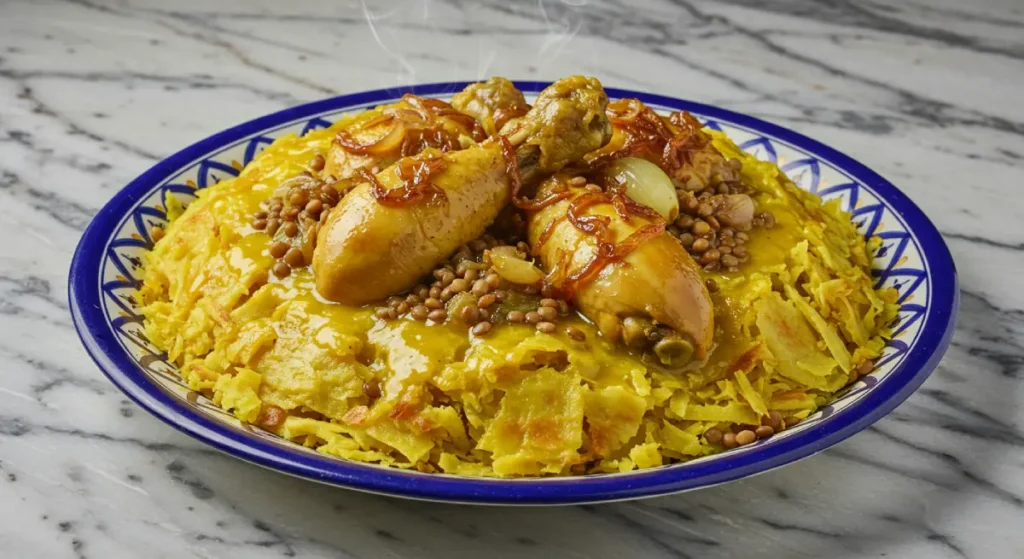
From the fragrant saffron-infused broth to the delicate layers of msemen soaking up the spiced lentils and chicken, every bite of Rfissa tells a story of heritage, warmth, and togetherness.
💡 Why Rfissa Stands Out as a Typical Moroccan Meal
✔ A Dish with History – Rfissa has been passed down through generations, carrying the essence of Moroccan culinary wisdom.
✔ A Celebration of Flavors—The perfect balance of spices, tender chicken, and hearty lentils makes this a truly comforting meal.
✔ A Symbol of Moroccan Hospitality – Whether shared during family gatherings, postpartum recovery, or festive celebrations, Rfissa represents the Moroccan spirit of generosity and care.
✔ Versatile & Adaptable – With regional variations and healthier alternatives, this dish can be customized to suit different preferences while maintaining its authentic charm.
🍽️ Bringing Rfissa into Your Kitchen
Now that you have explored the origins, ingredients, cooking techniques, and serving traditions of Rfissa, it is time to prepare this masterpiece.
✨ Follow the step-by-step guide to master the authentic Moroccan technique.
✨ Experiment with spices and textures to find your perfect balance of flavors.
✨ Enjoy Rfissa the Moroccan way—shared with loved ones and paired with traditional mint tea.
Whether you love Moroccan food or are discovering it for the first time, preparing Rfissa allows you to connect with Morocco’s rich culture through food.
📌 Final Thought: A Dish to Savor & Share
Rfissa is a typical Moroccan meal that combines comfort, tradition, and culinary artistry in one dish. Whether served for celebrations, special occasions or as a hearty homemade meal, it’s deep flavors and nourishing ingredients make it a true Moroccan treasure.
🔥 Now it’s your turn! Have you tried making Rfissa? Share your experience and let the flavors of Morocco come alive in your kitchen! 🍽️🇲🇦
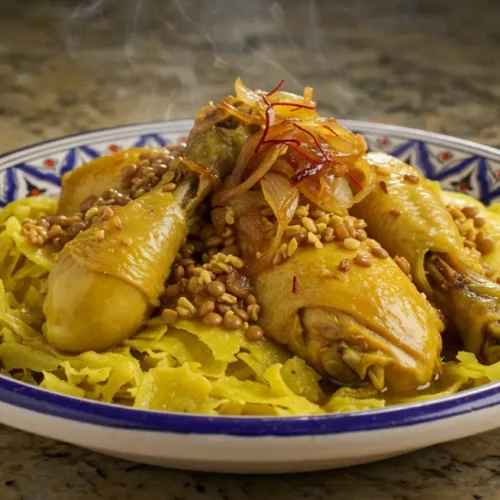
Typical Moroccan Meal: How to Make Delicious Rfissa
Ingredients
For the Chicken Broth:
- 1 whole chicken or 4 chicken thighs and drumsticks
- 2 large onions sliced
- 3 tbsp olive oil
- 1 tsp salt
- ½ tsp black pepper
- 1 tsp turmeric
- ½ tsp ground ginger
- ½ tsp paprika
- 1 tbsp ground coriander seeds
- A pinch of saffron threads soaked in warm water
- 1 tsp Rfissa spice mix or Ras el Hanout
- 1 tbsp smen fermented butter
- 1 bunch fresh coriander and parsley tied together
- 1 liter boiling water
For the Lentils & Legumes:
- 80 g dried lentils
- 50 g dried fava beans optional
- 50 g fenugreek seeds halba (soaked for 4 hours)
- 1 tsp nigella seeds
- 1 tsp cress seeds
For the Msemen (Trid):
- 6 msemen or trid Moroccan crepes, cut into bite-sized pieces
For Garnishing:
- 1 large onion caramelized in olive oil
- Boiled quail eggs optional
- Fresh coriander
Instructions
1️⃣ Prepare the Chicken Broth:
- In a large heavy-bottomed pot, heat the olive oil over medium heat and sauté the sliced onions until soft.
- Add the chicken and season with salt, black pepper, turmeric, ginger, paprika, and ground coriander.
- Stir well, then add saffron-infused water, Rfissa spice mix, and smen (fermented butter).
- Pour in boiling water, add the tied bunch of coriander and parsley, then cover and simmer for 45 minutes until the chicken is tender.
2️⃣ Cook the Lentils & Legumes:
- After 30 minutes of simmering, add lentils, fava beans, fenugreek, nigella seeds, and cress seeds to the broth.
- Stir occasionally and let it cook for another 30-40 minutes, until the lentils and beans are soft.
3️⃣ Prepare the Msemen Base:
While the broth is cooking, cut the msemen into small pieces and arrange them on a large serving plate.
4️⃣ Assemble the Dish:
- Once the chicken is fully cooked, remove it from the broth and place it under the grill for 5 minutes to get a golden, crispy texture.
- Pour ladles of hot broth over the msemen to let it soak up the flavors.
- Arrange the lentils and legumes evenly over the msemen.
- Place the grilled chicken on top, followed by caramelized onions and boiled quail eggs for garnish.
5️⃣ Serve & Enjoy:
- Serve Rfissa immediately, accompanied by Moroccan mint tea for an authentic experience.
Notes
- For a richer flavor, marinate the chicken with spices 1 hour before cooking.
- Adjust the spiciness by adding chili powder if desired.
- For a gluten-free option, substitute msemen with brown rice or gluten-free flatbread.
- If reheating, add a little water or broth to refresh the texture before serving.
📌 Nutrition Information (Per Serving)
| Nutrient | Amount per Serving |
|---|---|
| Calories | 620 kcal |
| Protein | 42g |
| Carbohydrates | 72g |
| Fats | 18g |
| Saturated Fats | 5g |
| Fiber | 12g |
| Sugars | 6g |
| Sodium | 780mg |
💡 Note: Nutritional values are estimates and may vary based on ingredient brands and portion sizes.
📩 Stay Connected with Us!
📩 Join Our Moroccan Foodie Community
Get the best Moroccan tagine recipes and seasonal culinary tips straight to your inbox.
Stay Connected & Explore More Moroccan Flavors! 🇲🇦✨
Love Rfissa and other typical Moroccan meals? Join me on social media for more authentic Moroccan recipes, cooking tips, and cultural insights! 📲 Follow me for step-by-step tutorials, behind-the-scenes kitchen moments, and a taste of Morocco at home. Let’s share our passion for Moroccan cuisine together!
🏠 Discover More Moroccan Recipes!
🥘 Craving more delicious Moroccan dishes? Head over to our Home page for a collection of authentic recipes, cooking inspiration, and flavor-packed meals! Explore now!
🔥 Now it’s your turn! Have you tried making Rfissa? Share your experience and let the flavors of Morocco come alive in your kitchen! 🍽️🇲🇦
